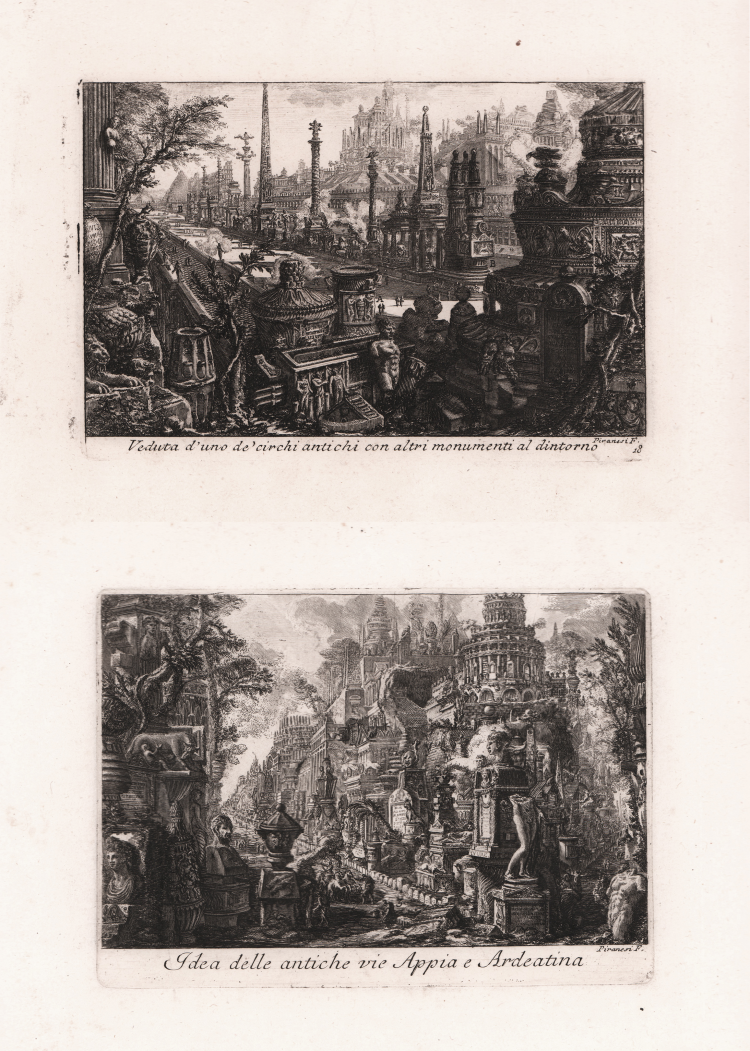





| Reference: | S30453 |
| Author | Giovan Battista PIRANESI |
| Year: | 1757 |
| Measures: | 215 x 155 mm |




| Reference: | S30453 |
| Author | Giovan Battista PIRANESI |
| Year: | 1757 |
| Measures: | 215 x 155 mm |
Pair of etchings, engraving and drypoint, 1757, signed in the lower right.
Magnificent proofs, printed on contemporary laid paper with watermark "double encircled lily with the letters CB", with wide margins, in excellent condition.
Smaller versions of the original title page of Volume II and Volume III of Roman Antiquities.
For the first time included in the Lettere di giustificazione scritte a Milord Charlemont e à di lui agenti di Roma ... intorno la dedica della sua opera delle Antichitá Rom[ane] fatta allo stesso signor ed ultimamente soppressa (1757) and subsequently included in some edition of Opere Varie from about 1760.
The primary attitude which characterised Piranesi's personality was an unequivocal disposition towards controversy, which distinguished the last thirty years of his life and, at the same time, furnished him with the indispensable vigour and constituted the foundations which were necessary for his outstanding achievements. However, his favourite means for upholding debates were not words but pictures, and his attempts to blame, defend himself and contend gave rise to some of his most extraordinary works. The first of these was the one under scrutiny, which included the letters written to the Irish aristocrat Lord Charlemont who, not only had not kept his promise to fund the Antichità Romane..., but also completely disregarded the complaint notes which Piranesi sent him.
The text of the Lettere di Giustificazione published in Rome in 1757, reproduced two of his letters to Charlemont together with another one addressed to Father Peter Grant, who had volunteered to settle the question.
This work outlined problems which were far more serious than a simple quarrel, delineating the changes which came about in the relationships between artists and their sponsors in the second half of the eighteenth century. The artist who, with his project, wanted to leave behind him an important milestone by describing ancient vestiges of Roman history, judged himself worthy of Lord Charlemont's esteem.
Therefore, this work of complaint had the aim of separating the Irish aristocrat's name from the Antichità Romane... since he was regarded as an unworthy patron. This was true up to the point that Piranesi had cancelled from the title-page of the first volume the text with which he had dedicated it to him. In this work, apart from a few satirical vignettes concerning Charlemont, the artist reproduced small-size versions of the four main title-pages included in his primary archaeological composition. These diminutive masterpieces generated considerable excitement in the artist, who decided to include the plates in the new edition of the Opere Varie published at the beginning of the 1760s.
|
Wilton Ely 746 & 747.
|
Giovan Battista PIRANESI (Mogliano Veneto 1720 - Roma 1778)
|
Italian etcher, engraver, designer, architect, archaeologist and theorist. He is considered one of the supreme exponents of topographical engraving, but his lifelong preoccupation with architecture was fundamental to his art. Although few of his architectural designs were executed, he had a seminal influence on European Neo-classicism through personal contacts with architects, patrons and visiting artists in Rome over the course of nearly four decades. His prolific output of etched plates, which combined remarkable flights of imagination with a strongly practical understanding of ancient Roman technology, fostered a new and lasting perception of antiquity. He was also a designer of festival structures and stage sets, interior decoration and furniture, as well as a restorer of antiquities. The interaction of this rare combination of activities led him to highly original concepts of design, which were advocated in a body of influential theoretical writings. The ultimate legacy of his unique vision of Roman civilization was an imaginative interpretation and re-creation of the past, which inspired writers and poets as much as artists and designers.
|
|
Wilton Ely 746 & 747.
|
Giovan Battista PIRANESI (Mogliano Veneto 1720 - Roma 1778)
|
Italian etcher, engraver, designer, architect, archaeologist and theorist. He is considered one of the supreme exponents of topographical engraving, but his lifelong preoccupation with architecture was fundamental to his art. Although few of his architectural designs were executed, he had a seminal influence on European Neo-classicism through personal contacts with architects, patrons and visiting artists in Rome over the course of nearly four decades. His prolific output of etched plates, which combined remarkable flights of imagination with a strongly practical understanding of ancient Roman technology, fostered a new and lasting perception of antiquity. He was also a designer of festival structures and stage sets, interior decoration and furniture, as well as a restorer of antiquities. The interaction of this rare combination of activities led him to highly original concepts of design, which were advocated in a body of influential theoretical writings. The ultimate legacy of his unique vision of Roman civilization was an imaginative interpretation and re-creation of the past, which inspired writers and poets as much as artists and designers.
|